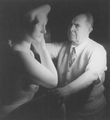Born in 1889 in Athens, he grew up at Korthi, Andros and came into early contact with sculpture at his father’s marble-working studio. He studied sculpture and drawing at the Athens School of Fine Arts (1903-1909) under Georgios Vroutos, Lazaros Sochos, Alexandros Kaloudis and Dimitrios Geraniotis. Initially he worked at the studios of his father and N M Perakis before starting his own studio in Athens. He continued his studies on a scholarship at the Academie Julian in Paris (1914).
He taught as professor of Sculpture at the NTUA’s School of Architecture from 1919 to 1923, when he resigned due to the negative reactions to his critique against the establishment of a War Museum. After his first solo exhibition in Athens (Stratigopoulou Gallery, 1924) and until 1928 he spent periods of time in Paris and acquainted himself with the contemporary art trends. In 1933 he launched
Eikostos Aionas, the first Greek magazine exclusively devoted to the visual arts.
In 1938, during the Metaxas regime, he was appointed professor at the 2nd sculpture workshop of the School of Fine Arts, serving as director in the years 1957-1959 and teaching until 1960. He was also Fine Arts Director of the Ministry of Education in 1943, during the German occupation. After the war he faced charges for his collaboration with a Fascist magazine but was exonerated. In 1967 he received the Fine Arts Award of the Academy of Athens, to which he was elected in 1968.
His numerous monumental works (public commissions for statues and busts) demonstrate his sound knowledge and respect for the visual conventions of academic art. However, part of his independent sculpture shows the clear influence of French modernism, particularly cubism and abstraction. In several cases he experiments with avant-garde forms, especially after 1950. His alternating between academic conservatism and modernist references is one of the characteristic traits of his oeuvre.
In addition to his artistic work he published many articles in newspapers and magazines.
He presented his work in many solo and group exhibitions. He participated in the exhibitions of “Omada Techni” (1917-1919) and represented Greece in the Biennale of Venice (1934, 1938, 1956) and Sao Paolo (1955). A permanent exhibition of his works operates at the Goulandris Foundation’s Museum of Contemporary Art in Andros. Works of his are also hosted in the National Gallery, the Gallery of the City of Athens and in many other private and public collections.
Tombros Michalis (1889 - 1974)





